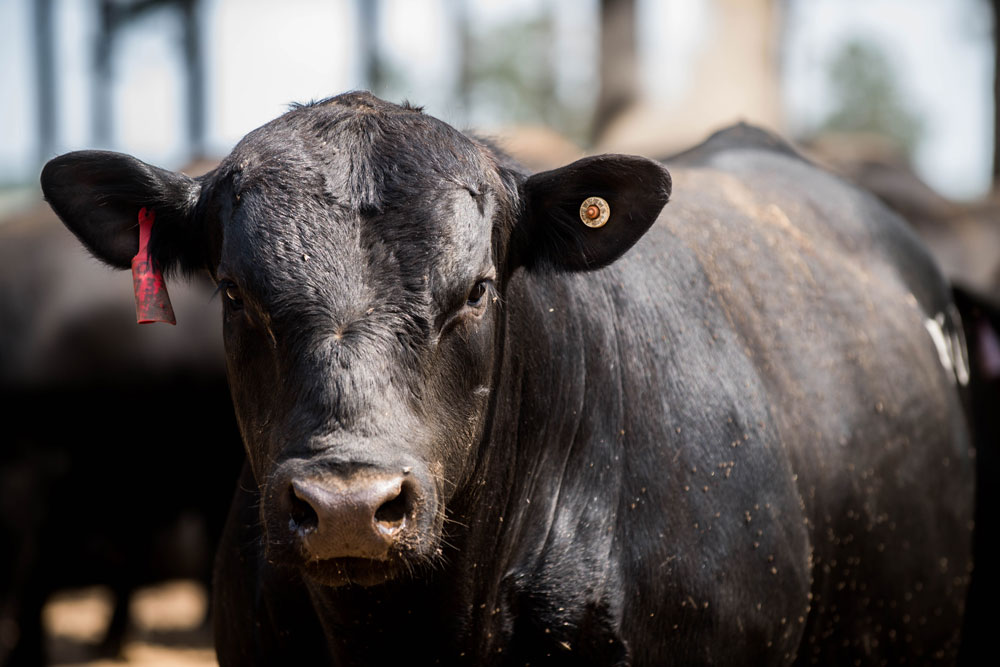
New thresholds for Targeting the Brand™
by Miranda Reiman
May 28, 2020
When you have better data you, you can make better decisions.
That’s why the Targeting the Brand™ program was recently updated: so that commercial cow-calf producers better find sires that help them hit Certified Angus Beef ® (CAB®) brand specifications.
“If a bull buyer wants a calf crop that has a greater chance of making CAB, it helps him identify the genetics that will help him do that,” says John Grimes, owner of Maplecrest Farms, Hillsboro, Ohio, and CAB board chair. “The trait that sorts cattle out of CAB quicker than anything is lack of marbling.”
Since 2017, breeders and bull studs have used the Targeting the Brand logo to denote bulls that excel in the marbling (Marb) EPD (expected progeny difference) and the Grid Dollar Value Index, or “dollar G” ($G).
The standards had been based on bulls at breed average or better for both measures.
“If we could keep moving average higher, that was a step in the right direction, and we based that on the best information we had,” says Kara Lee, CAB production brand manager.
But 8,600 actual carcass records recently provided real-world measurements and supported the move to refine those thresholds.
Angus Genetics Inc. analyzed the records to find the combined Marb and $G minimum levels likely to produce CAB from at least half of a calf crop. The updated Targeting the Brand requirements—now at +0.65 for Marb and +55 for $G—align with that analysis.
Slightly higher than the previous breed average requirement, one in four non-parent Angus bulls now qualifies for the designation. Those numbers will be evaluated every two years, and adjusted based on the most current information.
Why a 50% CAB acceptance rate?
“Today’s nationwide average is 35%, but we are really looking at how we continue to meet and grow demand,” Lee says, noting a two-billion-pound sales goal the next decade or so.
“If everyone wants to get a piece of the pie, we have to keep making the pie bigger,” she says. “That’s a cliché a lot of people use, but the bigger the CAB pie becomes, the more room for commercial producers to capitalize on the value of buying high-quality registered Angus bulls.”
The more demand, the better the pull-through model works.
“The one-billion-pound mark seemed unachievable not too long ago. What can we do to keep that growth curve going up?” Grimes asks. “Breeders have done a great job of increasing the percent of cattle that qualify for CAB, but to get to that lofty goal of two billion pounds? We’ve got to do better.”

He encourages breeders to use the marks, and make sure their customers know what they mean.
“These are just minimums,” Lee says. Producers who already get 50% or higher CAB acceptance rates should aim even higher.
“We know marbling is highly heritable. We know that genetics impact roughly 40% of the marbling potential in those cattle; but that said, there’s another 60% not explained by genetics,” Lee says. When environment plays a role, high-quality management has to match to get intended results. “The Targeting the Brand logo is not a guarantee that progeny from any animal will hit CAB. It’s an indication that the genetic potential is higher with that animal.”
And the sire is only half the equation.
“There are some people out there who will say, ‘All Angus grade high,’ or, ‘The average Angus is good enough,’” Grimes says. “But we don’t feel like average is good enough. The database says we have to up our game.”
Don’t mistake that for a marbling-only message though.
“These numbers give producers a lot of latitude to place emphasis on carcass but still select for other traits that we know are really important,” Lee says. “We always discourage producers from single-trait selection.”
History shows progress can be made on multiple fronts at the same time, Grimes says.
“People used to think we couldn’t have calving ease and high growth, and breeders have shown that they can do that. So it’s not realistic to think we can’t do the same with elite carcass merit and maternal function,” he says.
More than 130 sales used the logo during the 2019-2020 sale season—that number up 76% in two years—to identify more than 6,500 Angus bulls with a likelihood of siring brand qualifiers.
“We have tremendous tools available to registered breeders through the Association, and they all serve a purpose, but we also know digesting all that information can be a challenge for the average commercial producer,” Lee says. “Targeting the Brand is a way to help those looking to keep a focus on carcass quality.”
You may also like
You, Your Cows and Their Feed
Expert guidance from Dusty Abney at Cargill Animal Nutrition shares essential strategies for optimizing cattle nutrition during droughts, leading to healthier herds and increased profitability in challenging conditions.
Benoit Angus Ranch honored with CAB Seedstock Commitment to Excellence Award
What started with six Angus heifers, has now grown into 400 Angus females, along with a 2,500 acre farming division. The multi-generation family business focus on improving the reputation on the ranch with high-quality cattle. From the ground up, Benoit Angus Ranch has earned the CAB 2023 Seedstock Commitment to Excellence Award.
Everything They Have
Progress is a necessity on the Guide Rock, Nebraska, ranch where Troy Anderson manages a commercial Angus herd, small grower yard, his 10-year-old son, and a testing environment. Troy’s approach includes respect for his livestock, people and land. For that, Anderson Cattle was honored with the CAB 2023 Commercial Commitment to Excellence Award.

